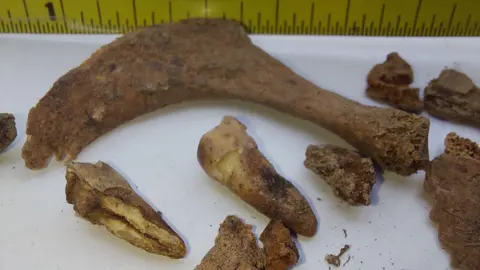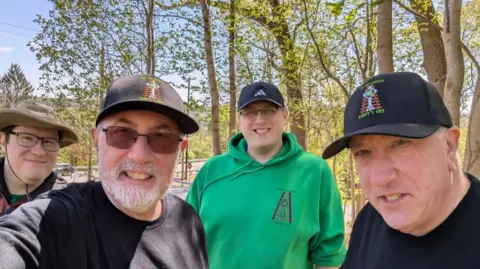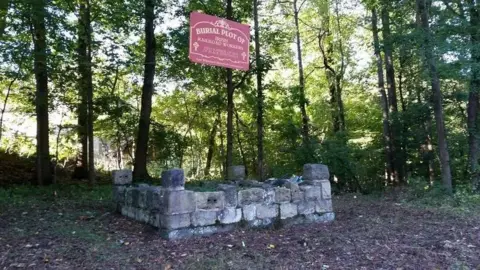US mass grave could contain remains of up to 120 Irish immigrants
 Duffy's Cut Project
Duffy's Cut ProjectA 19th Century mass grave in Pennsylvania could contain the remains of up to 120 Irish immigrants, researchers have said.
The site, at Downingtown, is 11 miles west of Duffy's Cut, where in 2009 remains from a mass grave believed to contain 57 Irish railroad workers were discovered.
Those immigrants, from counties Tyrone, Londonderry and Donegal, were buried there after a cholera outbreak in 1832.
One of those buried at the new grave site is believed to have fled from Duffy's Cut, possibly bringing cholera with him.
The discovery was made by a team led by twin brothers Frank and Bill Watson, who have been working to uncover the remains of Irish rail workers in the area for more than 20 years.
The remains of seven of those found at Duffy's Cut were previously uncovered and reburied by the team.
While some of the work crew may have died of cholera, the seven who were found had suffered violent deaths, believed to have been at the hands of local vigilantes.
 Duffy's Cut Project
Duffy's Cut ProjectThe first set of remains at the new site were discovered in May by geophysicist Matt Peace, on land owned by Northwood Cemetery.
"We knew from our historical sources that another Irish work crew connected to Duffy's Cut died and was buried there and we do suspect foul play," Frank Watson said.
"But now we actually have bones in hand and we've located the first human remains."
The remains found at Downingtown include parts of a man's face, including the jaw and two teeth.
Frank said the grave is likely to contain the remains of as many as 100 to120 people as an entire crew, including Irish-born contractor Peter Connor, "disappeared from history".
Bill said they hoped to get DNA from the teeth found in order to find living descendants so the remains could be buried properly.
He added that the immigrants at Downingtown were likely from the same parts of Ireland as those at Duffy's Cut.
He said the man who fled to Downingtown from the cholera quarantine at Duffy's Cut "went there for a reason, probably to escape to people who he knew".
 Duffy's Cut Project
Duffy's Cut ProjectFrank Watson said the workers previously found at Duffy's Cut had suffered brutal deaths.
"They were beaten about the head - there were no defensive wounds so they were tied up before they were killed," he said.
"One man was axed in the head – the tall man we call him – from behind and then when he was down he was shot in the head."
He said anti-Irish sentiment, competition for jobs and the scapegoating of the immigrants for the cholera outbreak led to the violence.
"Tough living conditions, hard work, but with the hope of a better life, that sadly ended in a mass grave," he added.
 Duffy's Cut Project
Duffy's Cut ProjectBill said the industrial revolution was a "tidal wave of change" but this progress came at a "great price".
He said many who died were placed in mass graves and it was not unusual for entire work crews to disappear.
"We have about 10,000 to 15,000 Irish immigrants who died building the [US] industrial infrastructure through the 1820s and 1830s, at various sites from Erie Canal to the New Orleans Canal," he said
"Most of those individuals will never have their story told... Duffy's Cut was different, Downingtown we hope will be different as well."
'A matter of justice'
 Duffy's Cut Project
Duffy's Cut ProjectThe search at Duffy's Cut was restricted due to costs and proximity to the train line.
Franks hopes to find all of the remains at the new site in order for them to be buried, following forensic analysis.
"There are dozens and dozens and dozens of these poor individuals who came to America for a better life and their stories disappeared," he said.
"It's a matter for us of justice."

In 2015, the remains of a woman discovered at Duffy's Cut - Catherine Burns - were transferred across the Atlantic and reinterred in Clonoe, County Tyrone.
Parish priest Canon Benny Fee said he was "delighted" to hear the remains had been found and hopes that they have been a Christian burial.
"Wherever in this world a person – man, woman or child - is thrown into a hole, not a grave but just out of the way, that is a denial of their human dignity and their human rights."
The Watsons and their team will work through the coming weeks and months to uncover the remains of all those buried at Downingtown.
"We hope maybe we can find the entire crew. It promises to be an interesting summer," Bill said.
